The Future of Youth GymnasticsHow a progressive gymnastics school has broken tradition with free weightsBy Kim Goss Published: Fall 2003 In the past, most gymnastic coaches believed the best way—perhaps the only way—to strength train their athletes was by using solely gymnastic movements. Countless reps of bodyweight-only exercises such as dips, push-ups and pull-ups were considered the standard training protocol to make gymnasts strong. But the coaches at the Sandhills Gymnastics Academy in Pinehurst, North Carolina, didn’t think this training approach was sufficient for their athletes. “What I noticed with some of our gymnasts was that they had good static strength and endurance strength but they were not very powerful,” says Jim Ayars, one of the co-owners of the academy. “And a lot of these kids were too weak to do one proper push-up, or one dip, and if they couldn’t hold up their own bodyweight, they couldn’t get much out of any kind of bodyweight strength training.” Injuries were another concern with Ayars. In an attempt to make athletes more powerful, many gymnastic coaches relied heavily on plyometric training, training that some athletes were not physically capable of handling. “My concern was if they did a very high volume of plyometrics they were going to get injured,” says Ayars. “Some of our kids were simply not strong enough to do much in the way of plyometrics.” But, for Ayars, not just any kind of strength training would do. “A lot of athletes do bodybuilding-type routines,” says Ayars. “Many American female gymnasts tend to have a lot of hypertrophy in their quads, whereas many of our male gymnasts have a lot of hypertrophy in their upper body, but they’re not necessarily stronger than their European counterparts. Also, in gymnastics, that extra bodyweight can be something of a hindrance.” To resolve this dilemma, Ayars studied the training programs of the Eastern Europeans, and decided to model his program after theirs by focusing on heavier weights, lower reps and explosive exercises such as power cleans and push jerks. Ayars had a background in weight training, but he wanted to learn more about performing and teaching explosive weight training exercises. In addition to taking a coaching course sponsored by the United States Weightlifting Federation, Ayars and his athletes worked with nationally ranked weightlifter Jane Black on the finer points of the lifts. Initial response from parents to Ayars’ new strength training program was all over the map. “We had a small group that thought it was a fantastic idea, we had a big group that was apprehensive about it, and we had another small group that was certain we were going to cripple their kids.” Ayars recalls that despite offering a notebook of medical journal abstracts which concluded that weight training was safe, one parent insisted that her 11-year-old daughter not lift weights. “The parent said she talked to her kid’s PE teacher and a trainer at Gold’s Gym, and they told her that her daughter shouldn’t lift weights until she was 18. The parent pulled her daughter from the program and signed her up for soccer, and the girl injured her knee!” Although there is some perception that gymnastics is associated with a high risk of injury, Ayars says, “When you consider the number of participating hours we have, the injury rate in gymnastics is surprisingly low. The most common injury, and it’s not so much an injury as it is just an ache or a pain, may be to the ankles or wrists, and that’s usually for athletes who are just starting out who lack good conditioning. In the six years we’ve owned this gym there have only been three times when kids were hurt badly enough so they had to go to a doctor. One of those three happened during an open-gym situation in which a friend pushed a boy off something and he fell and broke his arm, and the other two were broken arms from just falling and landing badly.” Upon enlisting the support of most of the parents for his new strength program, Ayars had to sell the athletes on the weights. “Most of the younger ones were gung ho and thought it was the neatest thing in the world to lift weights. Some of the older athletes, especially the female gymnasts, either had a fear that they were going to look like men if they weight trained or believed that weight training wasn’t important.” Flipping for the Program Once the new strength program was underway at Sandhills and the positive results rolled in, enthusiastic support replaced the former resistance. In his current program, Ayars introduces weight training to athletes as young as seven years old, having them do squats with a light bar, or even a broomstick, to teach the technique. “We start them with light weights they can handle easily so they can work on technique, and then we just slowly pyramid the weight up.” Ayars keeps the reps in the three-to-five range, increasing weight as long as the athlete’s technique is good. “As we raise the weight, I expect their speed to slow down a little bit, but we will stop them if their technique worsens.” On squats, Ayars allows them go as deep as desired as long as there is no bouncing. Despite the conservative nature of this method, Ayars has set a standard for the girls to power clean their bodyweight for three reps, and he already has five girls as young as 13 years old achieving it. He also wants them to squat their bodyweight, a goal that he says most of his athletes achieve quickly. One key auxiliary exercise in Ayars’ program is the overhead squat, one of the BFS power balance exercises. “My experience has been that the overhead squat is one of the best all-around body exercises an athlete can do,” says Ayars. “It works on flexibility, which of course the gymnasts need, and it’s very good for working on balance. In gymnastics, having the arms overhead during the exercise transfers well to what they do on the balance beam, because during part of the routine they will have their arms overhead and their knees bent.” A Strong Future with Gymnastics Although gymnastics is popular, especially at the Olympic level, the sport is not without controversy. A book entitled Little Girls in Pretty Boxes discusses some of the apparent abuses in gymnastics, especially in regard to promoting eating disorders. “The book painted the entire sport with a very broad brush,” says Ayars. “Some of those abuses may take place at the elite level, which is what you see at the Olympics, but the same can be said for other sports at the elite level. Truthfully, the sport that I hear receiving the most criticism for pressuring girls about their weight is cheer-leading.” “If you look at the gymnasts who compete at the junior Olympic level,” continues Ayars, “the problems described in that book really don’t take place with any greater frequency than they do in other sports. And if you look at college gymnastics, you’re not going to see a bunch of emaciated little girls—they’re athletic, healthy-looking young women.” Further, Ayars believes that all athletes can benefit from participating in the sport at some level. “It doesn’t matter what sport somebody plays, gymnastic training will help them be a better all-around athlete.” The Sandhills Academy of Gymnastics offers a variety of gymnastic programs, holding classes for those as young as 16 months all the way up to competitive junior Olympic teams. They also have popular recreational and tumbling classes. Ayars says that gymnastics usually costs more than most other sports, which he attributes to a lack of support from taxpayers who are more willing to subsidize main-stream sports such as baseball. Ayars is vocal on the subject of how public support affects gymnastics in this country: “Men’s gymnastics has been hurting at the international level because it’s really developed at the collegiate level, and over the past 10 to 12 years the college men’s gymnastics program has really been gutted. At the last Olympics our teams didn’t do too well, but since then our international women’s teams have been doing much better.”< |
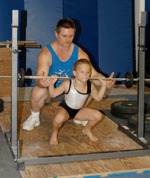 |
|
Coach Ayars spots Kyra Szabo |
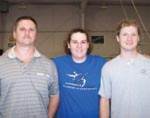 |
|
Strength Coach Jim Ayars, Program Director Jennifer Ayars, and Head Team Coach Joel Neuwirth |
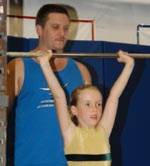 |
|
Coach Ayars coaches Laura Burns on the push press |
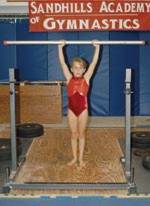 |
|
Elena D'Argenio keeps "eyes on target" during this push press |
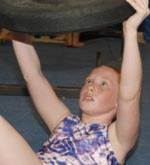 |
|
Kelcie Frye shows complete focus in this abdominal exercise |
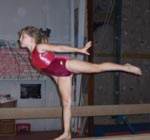 |
|
Proper training converts directly to effective results in competition. |
 |
|
Kacin Menendez, National Trampoline Champion, shows perfect form in this squat |
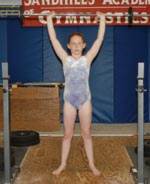 |
|
Push presses are a key exercise for young gymnasts at the Sandhills Academy |
 |
|
“Most of the younger ones were gung ho and thought it was the neatest thing in the world to lift weights,” said Coach Ayars |